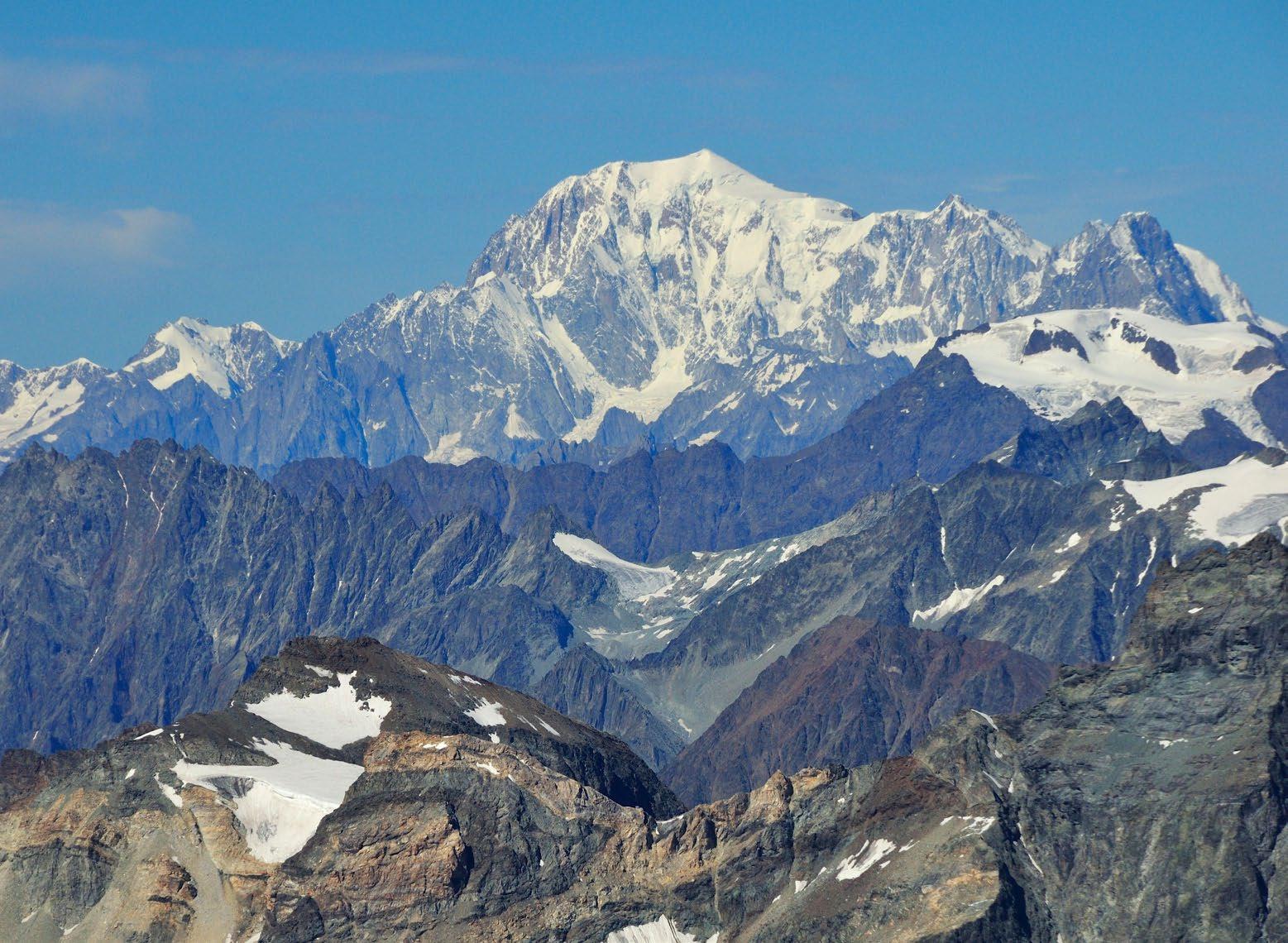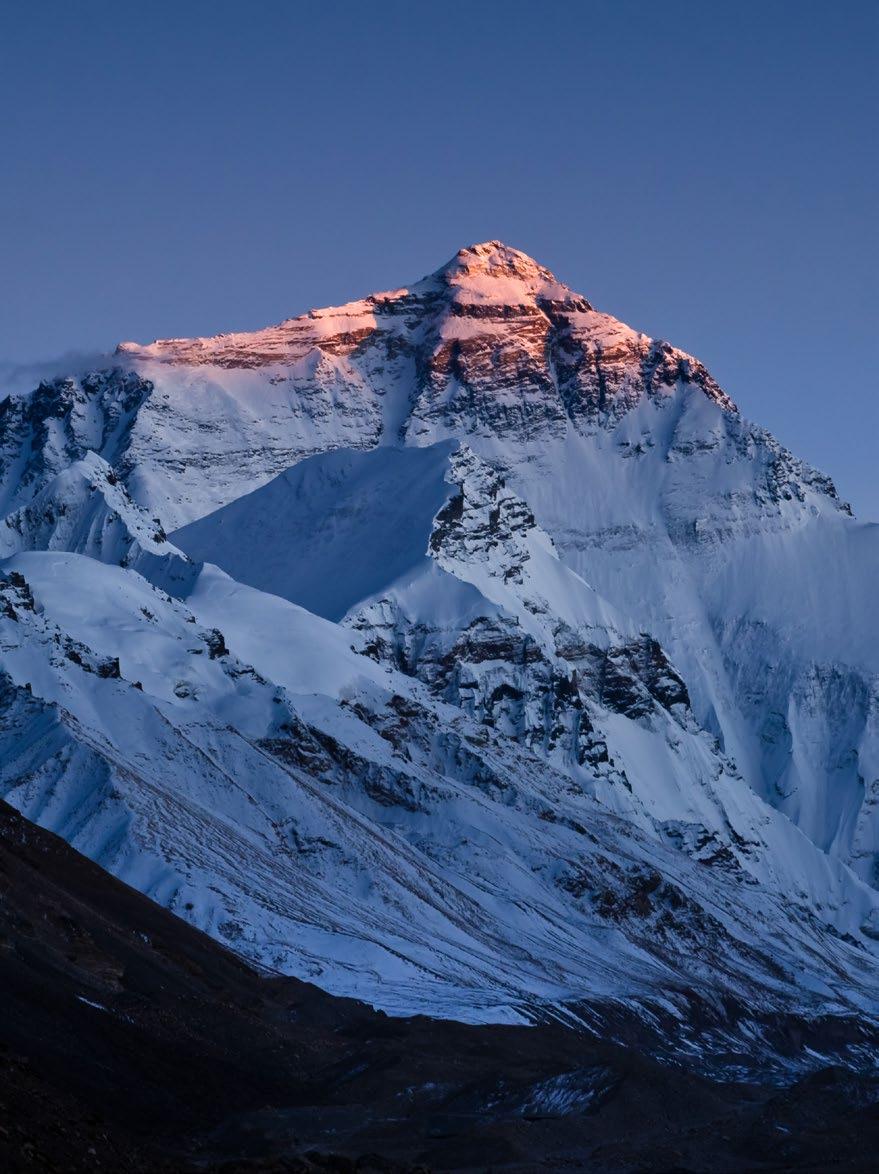
Publisher
Balthazar Pagani
Graphic design
Davide Canesi / PEPE nymi
WS White Star Publishers® is a registered trademark property of White Star s.r.l.
© 2023 White Star s.r.l.
Piazzale Luigi Cadorna, 6 20123 Milan, Italy
www.whitestar.it
Translation: Richard Pierce
Editing: Phillip Gaskill
All rights reserved. No part of this publication may be reproduced, stored in a retrieval system, or transmitted in any form or by any means, including electronic, mechanical, photocopying, recording, or otherwise, without written permission from the publisher.
ISBN 978-88-544-1995-7
Printed in ???
1 2 3 4 5 6 27 6 25 24 23
Beautiful PEAKS
Mountains with glorious history
Places of great spirituality
Text ~ NICOLA
~ ~ N I C O L A B A L O S S I R E S T E L L I ~
BALOSSI RESTELLI

DENALI Alaska, USA 13 MAUNA LOA Hawaii, USA ���������������������������������� 19 HALF DOME California, USA ���������������������������� 25 RORAIMA Venezuela/Brazil/Guyana 33 ALPAMAYO Peru ������������������������������������������������ 41 HUAYNA PICCHU Peru ����������������������������������������������� 49 LICANCABUR Chile/Bolivia 57 CERRO TORRE Argentina/Chile ��������������������������� 65 KIRKJUFELL Iceland ������������������������������������������ 77 MONT BLANC France/Italy 85 MATTERHORN Italy/Switzerland ������������������������� 95 THE CIME DI LAVAREDO Italy ��������������������������������������������� 105 KILIMANJARO Tanzania 115 TABLE MOUNTAIN South Africa �������������������������������� 123 ARARAT Turkey ������������������������������������������� 131 DAMĀVAND Iran 139 NANGA PARBAT Pakistan ��������������������������������������� 147 LAILA PEAK Pakistan ��������������������������������������� 157 K2 Pakistan/China 165 KAILASH China �������������������������������������������� 175 EVEREST Nepal/China ������������������������������ 185 AMA DABLAM Nepal 195 FUJI Japan � ������������������������������������������ 205 ULURU ( or AYERS ROCK) Australia ��������������������������������������� 215 • CON T ENTS • PROFOUND ALTITUDES 7







France/Italy
MONT BLANC

Altitude: 14,692 ft. (4478 m) a.s.l.
Prominence: 15,407 ft. (4696 m)
Topographic isolation: 1747 mi. (2812 km)
Coordinates: latitude 45°49’58” N; longitude 6°51’52.88” E
Location: Courmayeur, Chamonix
THE KING OF THE ALPS
The highest peak in the Alps and in all Europe was formed about 300 million years ago in the depths of the earth, when a gigantic magma bubble solidified and was transformed into granite. This immense block was then pushed upward by the fold in the Alpine Arc and rose up thanks to the erosion of the upper sediments. Its altitude is monitored continuously because of the changes in the layer of ice that covers the summit. Robust, wide, surrounded by 65 glaciers and by other mountains, Mont Blanc is not distinguished for its pointed peak shooting up to the firmament, but rather sits sedately like an old and wise warrior who doesn’t need to show his muscles. More than a mountain, it is a world, and as such bears infinite parallel entities within and on itself. Besides being a dessert and a brand, Mont Blanc separates Italy and
France while at the same time linking them via a tunnel almost 7 miles (11 km) long; it is crossed by cableways, furrowed by abandoned mines, and not only has the usual mountain refuges but also hosts important laboratories run by the Institute of Physics of Interplanetary Space of Turin. It has inspired poets—especially Englishmen, unfamiliar with mountains, on the Grand Tour—and has contributed to the creation of the mountaineering story genre. In a tragic and sublime example of things gone haywire that is almost superfluous to underscore, Mont Blanc has been the theater of heartbreaking events such as episodes of war, serious airplane accidents, the terrible tunnel fire that cost 39 lives, and naturally the continuous tribute of blood required by mountaineering (it is estimated that more than 6000 persons have died over the years).
• 85 •
The same bittersweet cloud envelops the account of the first official ascent of Mont Blanc. The collector of crystals Balmat and the physician Paccard were the first to set foot on the summit, after a climb of almost 15 hours. It was late afternoon on 8 August 1786 according to the precious diary kept by the Prussian Baron Von Gersdorff, who was observing them with binoculars from a ledge above Chamonix. Less than half an hour later, the two departed, reaching the French town after spending the night bivouacking. At Chamonix, Balmat learned of the death of his newborn daughter, which had occurred the day before, while he was finishing the ascent.
The following year, the Genevan scientist De Saussure, an enthusiastic supporter and sponsor of the feat, decided to make the climb as well and did so with Balmat and a super team of 18 guides who carried provisions, scientific instruments, and, it seems, even a camp bed. For quite some time, due to jealousy and mystification, this second ascent usurped the first one, deleting Paccard’s name from the account. The physician obtained posthumous justice only in the early 20th century, when Barone Von Gersdorff’s famous diary cropped up.


• 86 • SO R R O W O F C O N Q U E ST T H E J O Y A N D
~

• 87 •



Nepal/China

EVEREST
Altitude: 29,029 ft. (8848 m) a.s.l.
Prominence: 29,029 ft. (8848 m)
Topographic isolation: infinite
Coordinates: latitude 27°59’17” N; longitude 86°55’31” E
Location: Khumbu glacier, Nepal-China border
BECAUSE IT’S THERE
Chomolungma (Mother of the universe), Sagaramātha (God of the sky), or, more simply, Everest (after George Everest, a British surveyor): the highest mountain in the world, with 60 million years of history. The first (literal) victim of its fascination was George Mallory, who led many expeditions in the 1920s. His explanation of such obstinacy is famous and endearing. When asked why he insisted on climbing Everest: “Because it’s there.” To this day, no one knows whether he actually reached the summit. What is certain is that his body lay 820 feet (250 m) from the summit from his death in June 1924 to 1999, when it was finally found. Although the most accredited hypothesis is that he died before completing the ascent, the fact that the photograph of his wife he had taken with him was missing leaves room for the romantic theory that he
had left it on the peak, as he had intended. Be that as it may, Mt. Everest was officially conquered in 1953 by Edmund Hillary (later Sir) and Tenzing Norgay, who decided not to reveal which one had first set foot on the summit. Tenzing, who at first seemed to be rather nondescript, turned out to be an extremely fascinating person. Of more than humble origins, during his childhood he moved from Tibet to Nepal, became a porter, and then, thanks to his skills, was an active member of many expeditions, enjoying fame and influence after the Everest exploit. Curiously enough, his birthday coincides with the date of the celebrated climb, and not by chance: he himself chose it, since he didn’t know when he had been born, which seems to be 1914, the Tibetan Year of the Rabbit. Hillary and Tenzing searched in vain for some sign of the passage
• 185 •



• 218 •

• 219 •













